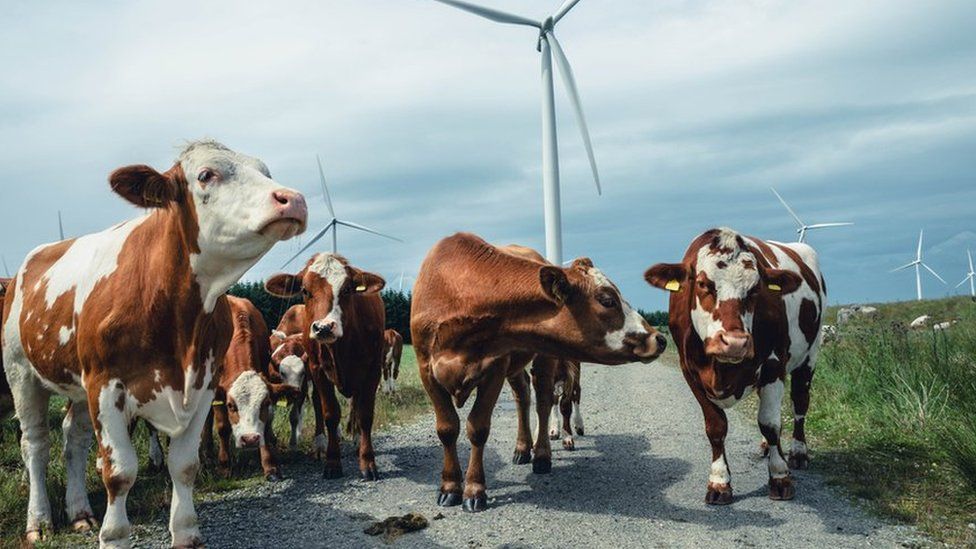What is net zero and how are the UK and other countries doing?
- Published

A new commitment to reduce fossil fuel use to tackle climate change was agreed at the COP28 summit in Dubai.
The deal emphasises the importance of reaching "net zero" by 2050 to avoid the worst consequences of global warming.
What does 'net zero' mean?
Net zero means no longer adding to the total amount of greenhouse gases in the atmosphere.
Greenhouse gases include carbon dioxide (CO2) and methane. CO2 is released when oil, gas and coal are burned in homes, factories and to power transport. Methane is produced through farming and landfill.
These gases increase global temperatures by trapping extra energy in the Earth's atmosphere.
Meanwhile, rapid deforestation across the world means there are fewer trees to absorb CO2.
Under the 2015 Paris climate agreement, 197 countries - including the UK - agreed to try to limit global temperature rises to 1.5C by 2100.
To achieve this, CO2 emissions need to fall by nearly half by 2030 and reach net zero by 2050, according to the UN's climate body, the IPCC. But these emissions remain at record highs.
Would net zero mean a complete end to greenhouse gas emissions?
Not all emissions can be reduced to zero, so those that remain need to be matched by actively removing greenhouse gases from the atmosphere.
Natural removal methods include planting trees and restoring peatlands.
There are also human-made machines - at very early stages - which are capable of removing CO2 directly out of the air.
Carbon capture is a related technology, where CO2 produced in power stations or other industrial processes is captured before it is released into the atmosphere, and stored underground.
While these technologies could be important in future, they are expensive, and can currently only cancel out a very small fraction of greenhouse gas emissions produced.
They are not a substitute for making drastic cuts to fossil fuel use, the International Energy Agency warns.
What is the UK doing on net zero?
To help achieve its 2050 target, the UK government has made a series of ambitious pledges, which include:
- achieving fully "clean" electricity by 2035, by rapidly increasing wind, solar and nuclear power
- making 80% of new car sales "zero emission" by 2030
- capturing and storing between 20 and 30 million tonnes of CO2 a year by 2030
- installing 600,000 electric heat pumps a year by 2028.
The UK has made significant cuts to its greenhouse gas emissions to date. These have fallen by nearly 50% since 1990.
However, this figure only includes emissions generated within the UK, and not those produced from goods manufactured overseas which the UK imports. This means it doesn't capture the UK's full carbon footprint.
Despite relatively strong past performance, there have been stark warnings about the UK's ability to meet its future targets.
In June 2023, the government's independent advisers, the Climate Change Committee (CCC), warned of "worryingly slow" progress. It said confidence that the UK would meet emissions targets in the 2030s had "markedly declined" from a year earlier.
Then in September, PM Rishi Sunak announced a series of changes to net zero policies.
These include delaying the ban on new petrol and diesel cars from 2030 to 2035, and an exemption meaning 20% of households would "never have to switch" to an electric heat pump.
The CCC argues the changes will make net zero even "harder to achieve".
Under the Paris climate agreement, the UK needs to reduce its emissions by 68% by 2030 compared with 1990 levels - a key step towards achieving net zero by 2050.
What have other countries promised?
About 145 countries have - or are considering - net zero targets, covering about 90% of global emissions. However, not all have set a 2050 deadline.
China - currently the biggest producer of CO2 worldwide - aims for "carbon neutrality" by 2060. Its plans to cut emissions aren't fully developed, but its renewable energy sector has been growing rapidly.
The US has historically been the biggest carbon emitter, and still emits more than China per head. It has pledged to reach net zero by 2050. In August 2022, it announced a major green investment package called the Inflation Reduction Act, which aims to boost renewables and other clean technologies.
The EU, the third biggest emitter of CO2, also has a 2050 net zero target. In March 2023, it announced its own green investment package, called the Net Zero Industry Act.
Russia and India are also significant emitters. They have pledged to reach net zero by 2060 and 2070 respectively, but have published few policies to back this up.
What is the problem with net zero targets?
There's controversy about how some countries might try to reach net zero.
For instance, a country might record lower emissions if it imports energy-intensive goods from overseas, rather than producing the goods itself.
But in reality, it wouldn't have reduced the total amount of greenhouse gases going into the atmosphere.
There are also schemes that enable rich countries to offset their emissions by paying poorer countries to switch to cleaner fuels.
But some climate scientists worry this could let wealthier nations avoid reducing their fossil fuel usage, by taking advantage of a switch to cleaner fuels in poorer countries which may have happened anyway.
What will net zero mean for individuals?
While the most significant changes need to come from government, individuals can also play their part to help reach net zero.
This could include:
- taking fewer flights
- reducing energy use
- improving home insulation and energy efficiency
- switching to electric vehicles
- replacing gas central heating with electric systems such as heat pumps
- eating less red meat